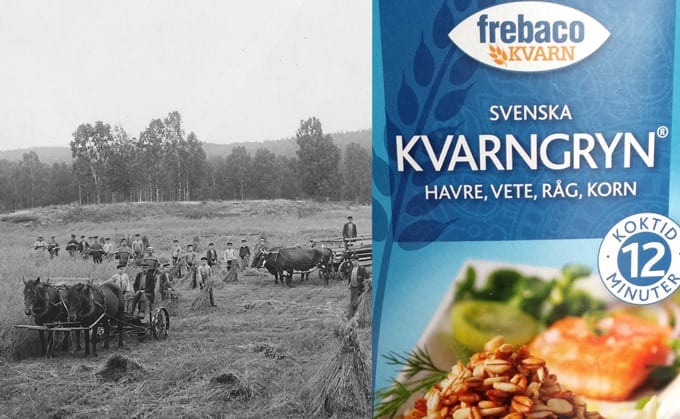Wheat, oats, cereals, mixed groats – the Nordic region’s new rice on the dining table. In fact, it is the grains we have been growing for a long time. The cereals can be cooked and eaten just like rice, but it is more than twice as climate smart as rice. Frebaco Kvarn on Västgötaslätten has made use of this.
There really is nothing strange about it. “Nordic rice” does not need to be processed, it is not a semi-finished product. Anyone can take the grain from the field and cook it for a meal. It is difficult to consume grain more naturally. What Frebaco does on Västgötaslätten is to shorten the cooking time from about 40–50 minutes to 10–15 minutes with a gentle steam preparation. The nutritional loss is minimal.
Grinding grain and baking bread is not wrong. But eating the grain whole is the least labor-intensive way and the most useful because you literally eat the whole grain.
We have delved deeply into the issue of this relatively undiscovered domestic food. Frebaco Kvarn in Lidköping is currently the only producer that delivers whole grains – food groats – to our grocery stores. We have put Staffan Pehrson, product manager at Frebaco Kvarn, on the spot regarding the company’s food groats products.
To begin with, why is it not more common to eat “Nordic rice”?
– Why you do not eat whole grains to a greater extent today is mainly due to the unfamiliarity of consumers. There is also another “ignorance” of the existence of the products, about their rapid cooking, their use and about their positive properties, both from a nutritional, taste and climate point of view.
What are the climatic aspects of the food groats?
– Compared to rice, our Swedish food grains cause significantly lower carbon dioxide emissions. This is confirmed in a report from SIK – the Institute for Food and Biotechnology.
How long have you been offering the food groats?
– We have been producing our organic Food Wheat since the start in 1981. We have been producing Food Barley, Food Oats and Mixed Groats for 2–4 years, depending on the product. We are the only producer that provides Swedish food groats and with a short cooking time.
What kind of grain do you use in cultivation?
– We use “ordinary” Swedish grain. Food wheat is organically grown while the others are conventionally grown. Everything is grown on Västgötaslätten which is unique because the soils naturally have very low levels of cadmium. We also do not allow the fields to be fertilized with sludge from treatment plants, which means that we also do not have any supply of heavy metals and other unwanted substances to the soil.
Are the crops for your products genetically modified? If not, why not print it out on the packaging?
– We do not allow genetically modified grain. That this is not stated on the packaging is due to the fact that the labeling rules do not allow this and that cereals have not been particularly much discussed in this context.
Why are your products not KRAV-labeled?
– Food wheat meets all the criteria for KRAV* labeling, but we have for various reasons opted out of it in favor of the at least equally well–known EU organic labeling. There is a greater relevance in marketing the origin and the climate–smart of buying Swedish food groats.
What happens to the grain when it comes to your mill from the field?
– When the grain comes to us, it is dried. We clean it before a very gentle steam treatment. It is then lightly rolled and then air–dried. In addition to the cleaning, both oats and barley must be peeled (the inedible chaff must be removed) before steam preparation.
Cereal food groats are probably the obvious alternative next to potatoes as a basic food in the Nordic cuisine, as there is no Swedish–grown rice or Swedish pasta. How would you describe the differences between pasta and rice?
– The food grains are by far better from a nutritional point of view than pasta and above all compared to rice. Pasta “should” be made from durum wheat, which is not grown in Sweden. There have previously been smaller cultivations of Swedish durum wheat on the islands of Gotland and Ven, but they are no longer available for large–scale food production. Durum wheat is not suitable for growing in Sweden for climate reasons.
How do you briefly describe the differences between the four cereals in terms of consumption for humans? You do not sell “food trays” especially e.g.
– Food wheat has a full–bodied, rich taste and wonderful chewing resistance. Food barley are a little milder and become a little softer when cooked. Food oats has a mild unique oat taste and is quite soft in themselves because oats naturally contain relatively much (wholesome) fat. Mixed groats consist of all four grains and are juicy and multifaceted in taste. That we do not have “food rye” is because the rye itself has a very strong and slightly “different” taste that does not suit the food. It’s a shame because rye has very good nutritional properties.
In times of crisis and difficulties in importing food to the Nordic countries, consumption of whole grains would be a good solution as it only requires cooking or soaking to be able to be eaten. As in the past, grain can be grown using only horses and mechanical tools. Cereals can be stored for several years, although the nutritional value naturally decreases gradually.
Food groats, just like potatoes, can be used as a basic food with both meat, fish, poultry and in vegetarian meals.
By choosing food groats for your kitchen instead of rice and pasta, you do not only benefit Swedish farmers and support our self–sufficiency, you also contribute to a significantly longer environmental impact. “Nordic rice” is simply smart food!
* KRAV is a label for organic food, produced without artificial chemical pesticides. KRAV was founded in 1985 in order to create a credible and broadly-based regulatory framework with associated certification and labelling of organic products.








